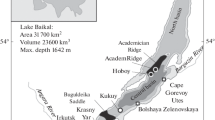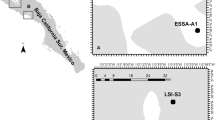Abstract
Microbial diversity and methanogenic potential in formation water samples from a dissolved-in-water type gas field were investigated by using 16S rRNA gene libraries and culture-based methods. Two formation water samples (of 46 and 53°C in temperature) were obtained from a depth of 700 to 800 m. Coenzyme F420-autofluorescence indicated that 103–104 cells per ml of active methanogens were present, accounting for at least 10% of the total cell count. The 16S rRNA gene sequence analysis indicated that the diversity of Archaea and Bacteria of the two samples was quite limited; i.e., the archaeal libraries were dominated by the sequences related to Methanobacterium formicicum and Methanothermobacter thermautotrophicus, and the bacterial libraries were dominated by the sequences related to Hydrogenophilus and Deferribacter. Of the methanogenic substrates tested using the formation water-based medium, only H2–CO2 gave rise to methane formation. Those dominant archaeal and bacterial genera have the potential to use hydrogen for growth at the in situ temperatures, suggesting that the formation water of the Pliocene strata in the gas field has been provided with hydrogen, probably from underneath the strata, and thus on-going active methanogenesis has been occurring to date.

Similar content being viewed by others
References
Altschul SF, Madden TL, Schaffer AA, Zhang JH, Zhang Z, Miller W, Lipman DJ (1997) Gapped BLAST and PSI-BLAST: a new generation of protein database search programs. Nucleic Acids Res 25:3389–3402
Apps JA, van de Kamp PC (1993) Energy gases of abiogenic origin in the Earth’s crust. In: Howell DG (eds) The future of energy gases. U.S. Government Printing Office, Washington, pp 81–132
Belyayev SS, Laurinavichus KS, Gaytan VI (1977) Modern microbiological formation of methane in the Quaternary and Pliocene rocks of the Caspian depression. Geochem Int 172–176
Bernard BB, Brooks JM, Sackett WM (1977) A geochemical model for characterization of hydrocarbon gas sources in marine sediments. Proc Offshore Technol Conf 435–438
Bryant MP, Boone DR (1987) Isoaltion and characterization of Methanobacterium formicicum MF. Int J Syst Bacteriol 37:171
Doddema HJ, Vogels GD (1978) Improved identification of methanogenic bacteria by fluorescence microscopy. Appl Environ Microbiol 36:752–754
Grabowski A, Nercessian O, Fayolle F, Blanchet D, Jeanthon C (2005) Microbial diversity in production waters of a low-temperature biodegraded oil reservoir. FEMS Microbiol Ecol 54:427–443
Greene AC, Patel BKC, Sheehy AJ (1997) Deferribacter thermophilus gen nov, sp nov, a novel thermophilic manganese- and iron-reducing bacterium isolated from a petroleum reservoir. Int J Syst Bacteriol 47:505–509
Gunsalus RP, Romesser JA, Wolfe RS (1978) Preparation of coenzyme M analogs and their activity in the methyl coenzyme M reductase system of Methanobacterium thermoautotrophicum. Biochemistry 17:2374–2377
Hayashi NR, Ishida T, Yokota A, Kodama T, Igarashi Y (1999) Hydrogenophilus thermoluteolus gen, nov., sp. nov., a thermophilic, facultatively chemolithoautotrophic, hydrogen-oxidizing bacterium. Int J Syst Bacteriol 49:783–786
Hobbie JE, Daley RJ, Jasper S (1977) Use of Nuclepore filters for counting bacteria by fluorescence microscopy. Appl Environ Microbiol 33:1225–1228
Hunt MH (1979) Petroleum geochemistry and geology. W. H. Freeman, San Francisco
Igari SI, Sakata S (1989) Origin of natural gas of dissolved-in-water type in Japan inferred from chemical and isotopic compositions: occurrence of dissolved-gas of thermogenic origin. Geochem J 23:139–142
Imachi H, Sekiguchi Y, Kamagata Y, Loy A, Qiu YL, Hugenholtz P, Kimura N, Wagner M, Ohashi A, Harada H (2006) Non-sulfate-reducing, syntrophic bacteria affiliated with desulfotomaculum cluster I are widely distributed in methanogenic environments. Appl Environ Microbiol 72:2080–2091
Japan Natural Gas Association (1980) Tennengas souran (Japanese). Japan Natural Gas Association, Tokyo, pp 299–307
Kamagata Y, Mikami E (1991) Isolation and characterization of a novel thermophilic methanosaeta strain. Int J Syst Bacteriol 41:191–196
Kanagawa T. (2003) Bias and artifacts in multitemplate polymerase chain reactions (PCR). J Biosci Bioeng 96:317–323
Kaneko N, Maekawa T, Igari SI (2002) Generation of archaeal methane and its accumulation mechanism into interstitial water. J Jpn Assoc Pet Tech 67:97–110
Kimura H, Sugihara M, Yamamoto H, Patel BK, Kato K, Hanada S (2005) Microbial community in a geothermal aquifer associated with the subsurface of the Great Artesian Basin, Australia. Extremophiles 9:407–414
Krumholz LR, Mckinley JP, Ulrich GA, Suflita JM (1997) Confined subsurface microbial communities in Cretaceous rock. Nature 386:64–66
Kvenvolden KA (1995) A review of the geochemistry of methane in natural gas hydrate. Org Geochem 23:997–1008
Magot M, Ollivier B, Patel BKC (2000) Microbiology of petroleum reservoirs. Anton Leeuw Int J G 77:103–116
Maidak BL, Cole JR, Lilburn TG, Parker CT, Saxman PR, Stredwick JM, Garrity GM, Li B, Olsen GJ, Pramanik S, Schmidt TM, Tiedje JM (2000) The RDP (Ribosomal Database Project) continues. Nucleic Acids Res 28:173–174
Nakai N, Yoshida Y, Ando N (1974) Isotopic studies on oil and natural gas fields in Japan. Chikyu kagaku (Japanese) 8:87–98
Noble RA, Henk FH (1998) Hydrocarbon charge of a bacterial gas field by prolonged methanogenesis: an example from the East Java Sea, Indonesia. Org Geochem 29:301–314
Nozaki Y (1997) Updated (1996 version) table of elements in seawater and its remarks. Bull Soc Sea Water Sci Jpn 51:302–308
Orphan VJ, Taylor LT, Hafenbradl D, Delong EF (2000) Culture-dependent and culture-independent characterization of microbial assemblages associated with high-temperature petroleum reservoirs. Appl Environ Microbiol 66:700–711
Patel G B (1984) Characterization and untritional properties of Methanothrix concilii, sp. nov., a mesophilic, aceticlastic methanogen. Can J Microbiol 30:1383–1396
Rice DD (1992) Controls, habitat, and resource potential of ancient bacterial gas. In: Vially R (ed) Bacterial Gas. Éditions Technip, Paris, pp 91–118
Sakai H, Gamo T, Ogawa Y, Boulegue J (1992) Stable isotopic-ratios and origins of the carbonates associated with cold seepage at the eastern nankai trough. Earth Planet Sci Lett 109:391–404
Sakata S, Sano Y, Maekawa T, Igari SI (1997) Hydrogen and carbon isotopic composition of methane as evidence for biogenic origin of natural gases from the Green Tuff basin, Japan. Org Geochem 26:399–407
Schoell M (1980) The hydrogen and carbon isotopic composition of methane from natural gases of various origins. Geochim Cosmochim Acta 44:649–661
Somerville CC, Knight IT, Straube WL, Colwell RR (1989) Simple, rapid method for direct isolation of nucleic-acids from aquatic environments. Appl Environ Microbiol 55:548–554
Stohr R, Waberski A, Liesack W, Volker H, Wehmeyer U, Thomm M (2001) Hydrogenophilus hirschii sp nov., a novel thermophilic hydrogen-oxidizing beta-proteobacterium isolated from Yellowstone National Park. Int J Syst Evol Microbiol 51:481–488
Sudo Y (1967) Geochemical study of brine from oil and gas fields in Japan. J Jpn Assoc Pet Tech 32:30–40
Suzuki MT, Giovannoni SJ (1996) Bias caused by template annealing in the amplification of mixtures of 16S rRNA genes by PCR. Appl Environ Microbiol 62:625–630
Sugisaki R, Ido M, Takeda H, Isobe Y, Hayashi Y, Nakamura N, Satake H, Mizutani Y (1983) Origin of hydrogen and carbon dioxide in fault gases and its relation to fault activity. J Geol 91:239–258
Weisburg WG, Barns SM, Pelletier DA, Lane DJ (1991) 16S ribosomal DNA amplification for phylogenetic study. J Bacteriol 173:697–703
Whiticar MJ, Faber E, Schoell M (1986) Biogenic methane formation in marine and freshwater environments: CO2 reduction vs. acetate fermentation-isotope evidence. Geochim Cosmochim Acta 50:693–709
Zeikus JG, Wolfe RS (1972) Methanobacterium thermoautotrophicus sp. n., an anaerobic, autotrophic, extreme thermophile. J Bacteriol 109:707–713
Zinder SH, Anguish T, Lobo AL (1987) Isolation and characterization of a thermophilic acetotrophic strain of Methanothrix. Arch Microbiol 146:315–322
Acknowledgments
We gratefully acknowledge Yutaka Yamada of the Japan Energy Development Co. Ltd for contributing the samples and for information about gas wells. We are also grateful to Shuichi Tokuhashi of Advanced Industrial Science and Technology for helpful comments about the geological structure of the natural gas field in Japan.
Author information
Authors and Affiliations
Corresponding author
Additional information
Communicated by K. Horikoshi.
An erratum to this article can be found at http://dx.doi.org/10.1007/s00792-008-0169-3
Rights and permissions
About this article
Cite this article
Mochimaru, H., Yoshioka, H., Tamaki, H. et al. Microbial diversity and methanogenic potential in a high temperature natural gas field in Japan. Extremophiles 11, 453–461 (2007). https://doi.org/10.1007/s00792-006-0056-8
Received:
Accepted:
Published:
Issue Date:
DOI: https://doi.org/10.1007/s00792-006-0056-8




